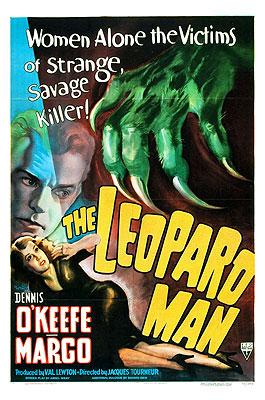 The Leopard Man (1943) **
The Leopard Man (1943) **
It’s hard to believe now, but there was a time when the major film studios used to churn out low-budget potboilers with a speed and frequency that would shame all but the most prolific of today’s direct-to-video schlock-peddlers. RKO was remarkable, however, in that that studio’s B-unit, overseen by producer Val Lewton, was dedicated expressly to producing horror films. The first Lewton production for RKO’s B-horror division was the legendary Cat People, directed by Jacques Tourneur. Cat People returned handsomely on a modest investment, while also earning a good bit of critical acclaim, and the Lewton-Tourneur team would produce two more movies the following year before other up-and-coming directors began stepping up to the RKO B-unit plate. The Leopard Man was the first of the RKO fright films to forgo even a hint of the supernatural. It’s also the one that looks the most like the contemporary B-level work of the other major production companies: well shot (albeit technically unambitious), passably acted, a bit on the tepid side, and shorter than Warwick Davis. Neither Cat People nor I Walked With a Zombie had been especially long, but The Leopard Man clocks in at an amazingly economical 66 minutes!
And it’s a good fucking thing too, because this is a movie that could seriously wear out its welcome at full feature length; as it stands, The Leopard Man ends just before boredom has a chance to get its hooks into you. The story is as stripped-down and simple as it gets. Jerry Manning (You’ll Find Out’s Dennis O’Keefe, whose career underscores the point I was making at the beginning of the last paragraph-- the man made 22 movies in 1936 alone!), who manages a struggling nightclub entertainer named Kiki Walker (Jean Brooks, of The Seventh Victim, who seems to have worked mainly in serials; she was in five of the “Falcon” chapterplays and had a tiny role in Flash Gordon Conquers the Universe, among others), has thought of a strategy to enable Kiki to outdo her arch-rival, Clo-Clo (played by Margo, who like her character apparently lacks a last name). Manning wants Kiki to come out onstage while Clo-Clo is still performing, leading a medium-sized black leopard on a leash. Talk about stealing the show! From the moment Kiki makes her entrance, nobody in the audience even seems to realize the other girl is there. But Clo-Clo avenges herself upon Kiki by clattering her castanets in the animal’s face, frightening it enough to pull itself loose from Kiki’s grasp and run off into the night. A few hours later (in The Leopard Man’s one really good scene), the animal stalks and kills a young girl whose mother had sent her out to buy cornmeal for tortillas. The posse formed the next day to hunt the beast meets with no success at all.
Then, despite the assurances of ex-university professor Dr. Galbraith (James Bell, of I Walked With a Zombie and about 10,000 cheap Westerns) that the leopard would head for open country rather than hang around the city, more dead bodies appear, all of them bearing what appear to be the marks of attack by the big cat. Manning, however, thinks Galbraith was right about the leopard, especially after he talks to its former owner, the implausibly named Charlie How-Come (Abner Biberman, who became a TV director after his career as a character actor fizzled in the 50’s; his credits include “Hawaii Five-O”, “The Fugitive”, and one of my all-time favorite TV shows, the original “The Outer Limits”). Charlie contends that the leopard attacked the first girl only because it was all wound up from fleeing first from Clo-Clo’s castanets and then from the flashlights and thumping pots and pans of the police. With no one chasing it, the leopard would have no real reason to attack humans, with whom it has always behaved gently and tamely. Nobody but Kiki buys Jerry’s theory that a human psychopath is at work, but it’s pretty obvious that he has to be right; the movie is called The Leopard Man, after all.
So Kiki and the boyfriend of one of the dead girls agree to help Jerry catch the killer. The trap they ultimately set is effective, if a bit far-fetched (relying as it does upon the assumption that one of the killer’s symptoms is paranoia), though the sequence in which it is sprung is so limply directed, and the subsequent confession scene so thoroughly lame as to undo most of what little Tourneur had accomplished in the preceding 55 minutes.
Basically, The Leopard Man comes across as exactly what it is: a cheap, short movie designed to keep at least a few butts in the seats after the headlining picture. A sense of, “Shit-- you realize this is the fifth one of these we’ve made this month?” pervades every aspect of the production, but on the other hand, so does an air of professionalism. The result is perfectly passable if you go into it expecting no more than the filmmakers seem to have.
Home Alphabetical Index Chronological Index Contact
